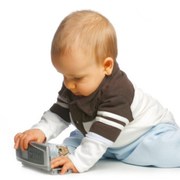 Photo: Getty Images
Photo: Getty Images
As our portable electronic devices get smaller, so do the batteries that power them. Hearing aids, watches, calculators, and toys all run on small “button batteries” about the same size as a coin.
Unfortunately, we have seen an increase in button battery ingestion by children that can result in serious injuries, health complications, and even death.
According to the National Capital Poison Center, nearly 3,500 people accidentally swallow a button battery each year. Furthermore, the American Academy of Pediatrics reported that the increase in severe cases of battery ingestion by children is directly related to the increase in the use of 20 mm lithium batteries.
These 20 mm lithium batteries cause the most severe injuries after ingested. The AAP further reports that nearly 40 percent of the lithium batteries in these cases were from television remote controls.
Parents will be glad to know that in most cases, after a child ingests a battery, the battery heads to the stomach and is later passed out through the intestines. However, if these tiny batteries don’t pass all the way through, they can cause severe injuries and sometimes death.
The esophagus is the most common place for the ingested battery to become stuck. NCPC explains that an electrical charge forms around the lodged battery, generating the caustic chemical, hydroxide.
The result is tissue damage to the windpipe, vocal cords, or heart. A child who has swallowed a battery that lodged in the esophagus may have to endure months or years of surgical repairs. However, if the ingested battery is removed within two hours, he or she can avoid serious injury.
If parents fear that a child has ingested a battery, they can dial the National Battery Ingestion Hotline or a poison control center. (See phone numbers, below.) If possible, have the battery information number available when you call.
The National Battery Ingestion Hotline will use the age of the child and the ingested battery size to determine if an immediate X-ray is required. The National Button Battery Ingestion Hotline is also available for consultation with family doctors and emergency room personnel.
While still at home, parents are reminded to NOT induce vomiting. Children should not eat or drink until an X-ray confirms that the battery is not stuck in the esophagus.
While waiting for the battery to pass, parents should report any signs of fever, vomiting, stomach aches or blood in the stool. Of course, keep an eye on the toilet until the battery has passed.
If anyone ingests a battery, call immediately:
24-hour National Battery Ingestion Hotline: 202-625-3333 (They accept collect calls)
Poison Center: 1-800-222-1222
Sources:
American Academy of Pediatrics. Battery Ingestion Injuries and Deaths on the Rise. Web. 30, Jan. 2012.
http://www.aap.org/en-us/about-the-aap/aap-press-room/pages/Battery-Ingestion-Injuries-and-Deaths-on-the-Rise.aspx
National Capital Poison Center. Swallowed a Button Battery? Web. 30, Jan. 2012. http://www.poison.org/battery
Reviewed January 31, 2012
by Michele Blacksberg RN
Edited by Jody Smith






Add a CommentComments
There are no comments yet. Be the first one and get the conversation started!